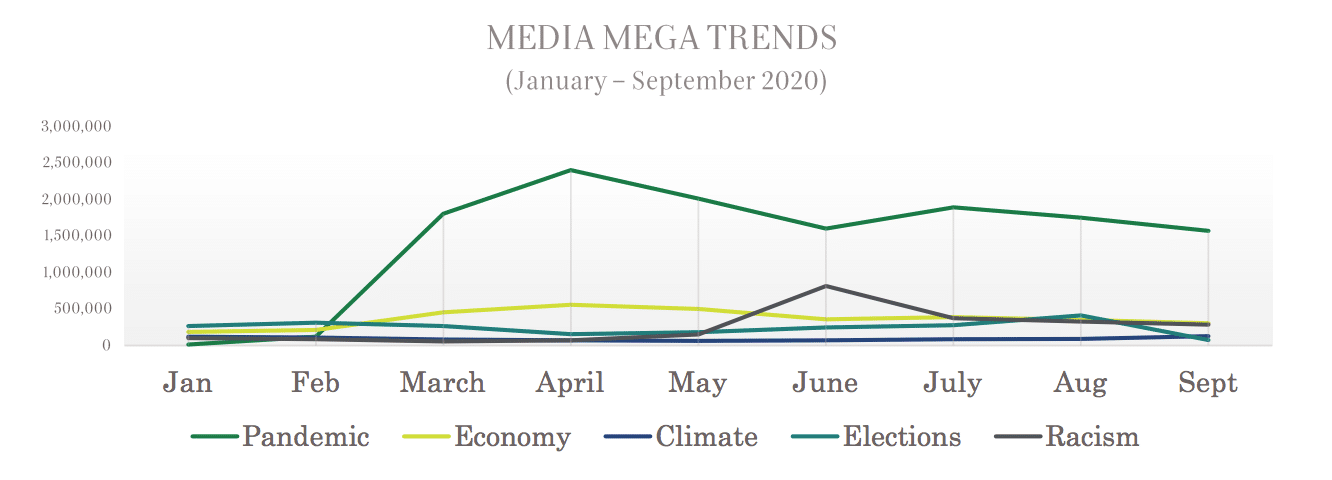Reading the news this year, it seems as though another major story breaks and upends the status quo every day. Between the coronavirus outbreak, a struggling economy, calls for racial justice, environmental catastrophe and a highly contested presidential campaign, there’s no shortage of media fodder. So how can organizations share their own stories in a way that’s mindful of larger circumstances while still impactful to their target audiences?
To help communications teams navigate an increasingly complex and crowded media state, V2 Communications published the Roadmap for Navigating the Media Landscape. The report, based on qualitative and quantitative research and analysis of U.S. media conducted between September 15 and October 9, 2020, reveals the mega trends newsrooms are currently focused on and details how brands can position themselves amid them. For PR professionals seeking to win journalists’ attention in today’s climate, here are the key takeaways they should keep in mind:
A look into America’s newsrooms
To supplement its research, V2 corresponded with journalists and editors at Forbes, Wall Street Journal, Business Insider, Bloomberg and other publications to secure direct media insights into the frontlines of today’s media. Their feedback? While journalists certainly aren’t short of stories in 2020, overall, it’s been a difficult year for newsrooms. Many reporters have had to pivot away from their typical beats to focus on mega events like the coronavirus outbreak and the election, which, coupled with outright job cuts, has left fewer people available to cover topics outside of that scope. Therefore, even if a company has a captivating story to tell, the publications that company is reliant on to get its story into the world might not have the capacity to tell it at the moment.
Media mega trends of 2020
Given that journalists are preoccupied with a narrower set of topics, it’s essential that communications teams have an awareness of how their narratives stack up in relation so that they can better manage media expectations and adjust their campaigns to be more timely.
While 2020 has affirmed that the news can be highly unpredictable, there are a few trends PR pros can expect in terms of media priorities over the coming months. Across outlets, the coronavirus has consistently been the most covered topic since March, followed, in varying order depending on date, by the economy, U.S. elections, racism and climate issues—and those trends are expected to pervade conversations for some time.
In the business press, COVID-19 continues to dominate headlines, with an emphasis on first-hand accounts, though conversations are evolving to unpack the longer-term impacts of the outbreak. As for broadcast media, stories with COVID-19 angles also persist as priority. For example, producers are still open to covering company profiles and speaking with C-suite executives, so long as talking points include COVID-19’s impact on their organizationsand how they’re working against it. Interest in coronavirus-related pitches pervades the tech press as well, though these outlets are operating closer to “business as usual.” When tech media does touch on mega trends, the stories are concerned with tech’s intersection with them (e.g., innovations for stopping the virus’ spread, concerns about deep fakes in the leadup to the election).
Implications for organizations
With news funnels tighter as journalists work to keep up with rapidly evolving mega trends, there’s increased onus on communications teams to be strategic. The criteria for what counts as “newsworthy” is currently much more stringent, and brands’ best chance at making waves is by mapping their narratives to overarching media themes. In other words, the topics they’d like to portray as news need to prove valuable to audiences outside of their immediate organizations. In like with this, the concept of an “embargo” is waning—with the news pipeline so saturated, the exact time and date a story runs is no longer a leading priority unless the content is truly breaking. Once journalists secure interest in a story, organizations need to be patient as they work the story into their own schedules.
Once communication teams find an angle that matters in today’s media climate, they should have their full story lined up to deliver to the outlet, including research and third party sources that can convince editors it’s a story worth telling (and that all the heavy lifting has already been executed). Alternatively, now is a ripe opportunity for organizations to invest in their own communication channels. Instead of battling for space in a saturated media landscape, companies can optimize their own social channels to deliver content on their own terms.
While today’s media landscape offers many hurdles to PR pros, it also presents an opportunity for them to devise strategic campaigns that will deeply resonate with audiences. The competition for journalists’ attention is tight, but if media relations practitioners can maintain the best practice of connecting their stories to what matters most to journalists’ audiences, and the issues they are impacted by, they’ll set themselves up for success in 2020 and beyond.









